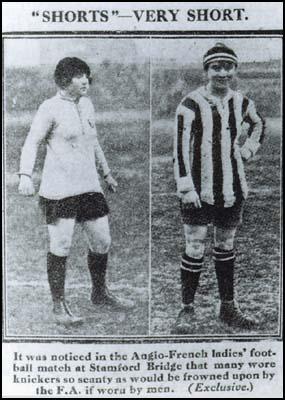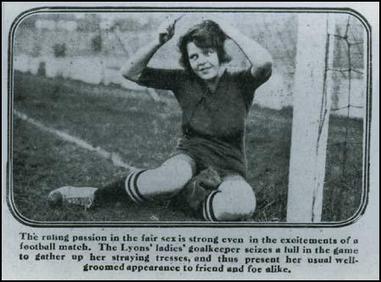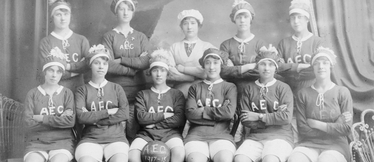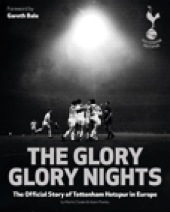 In Part 1 we looked at women's football's first steps. In this the second part we discover what happened next. How the game took hold during the early part of the last century and finally why it was banned. After those first games in North London the British Ladies next game was on 6th April 1895 they played a game in Brighton to raise funds for local medical charities. Then it was up to the North West and a game at Bury. Over 5,000 turned up to watch the game. One of the star players was the South’s left winger, Daisy Allen. The Bury Times described her as "a little sprite of four feet" and according to one report could be no more than 11 years old. Later that month the Bristol Times described her as a "plucky youngster who charged her bigger companions with great courage, and showed by her play that she had mastered the rudiments of the game, which could not be said for all." On Easter Monday 1895 the Ladies played on Reading’s Southern League ground and according to the The Berkshire Chronicle set a attendance record better any crowd for the Reading team. They later played in Scotland and at St James’s Park in Newcastle.  Sport was encouraged. Football was played in lunch breaks and would develop into works teams. One of these was the Dick, Kerr factory in Preston. One of their ladies later recalled. "We used to play at shooting at the cloakroom windows. they were little square windows and if the boys beat us at putting a window through we had to buy them a packet of Woodbines, but if we beat them they had to buy us a bar of Five Boys chocolate." On Christmas Day 1917 they played a game at Preston’s Deepdale ground the first game at the ground since the war started. Over 10,000 turned up to raise money for the local hospital. This was the start of many such games. After the war women's football continued. It was now met with more opposition as men returned from the war wanting to reclaim their jobs and their sport. One of Parrs team recalled being treated as an outcast by her boyfriend's family because they did not approve of her wearing shorts and showing her legs. Then in 1920 they played four games against a French national team. The first ‘international’ since those Scottish games. In the October they traveled to France for a return series. The first game in Paris played before more than 20,000 ended five minutes early when at 1-1 he ref awarded the English a corner which led to a pitch invasion. In December 1920 they played a game against the Rest of England to raise funds for the wounded. To increase the gate it was played in the evening and the government minister Winston Churchcill gave permission for two searchlights and forty flames to be used to be use as floodlights. To help the players the balls were also being dipped in whitewash throughout the game. On Boxing day 1920 more than 53,000 crowded in to Goodism Park to watch a game. The women all had full time jobs and had to fit playing in around them but they did receive expenses. Their manager insisted they were treated property. One of the ladies wrote ‘he also expected the best from us in return. we weren't allowed to wear trousers anywhere in public, it wasn't done in those days. We could do what we liked on the bus when we were traveling, but we had to change back into our skirts or dresses in the bus before we met any of the officials, that was a must." Things turned against them when they started to play games to raise money for men on strike from the mining industry. It was felt football should not be used as a political tool. Once again the issue was raised about the health risks of women's football. The FA produced a doctor who claimed "There are physical reasons why the game is harmful to women. It is a rough game at any time, but it is much more harmful to women than men. They may receive injuries from which they may never recover." Dr Mary Scharlieb, a Harley Street Physician added: "I consider it a most unsuitable game, too much for a woman's physical frame."  Lyons - A chain of tea shops which had their own team Lyons - A chain of tea shops which had their own team Women’s football fought back. The captain of Huddersfield Atalanta argued: "If football were dangerous some ill-effect would have been seen by now. I know that all our girls are healthier and, speaking personally, I feel worlds better than I did a year ago. Housework isn't half the trouble it used to be, because there is always Saturday's game and the week night training to freshen me up." While the captain of Plymouth Ladies gave an interview where she argued: "The controlling body of the F.A. are a hundred years behind the times and their action is purely sex prejudice. Not one of our girls has felt any ill effects from participating in the game." That's Plymouth top image training on the beach. On 5th December 1921, the FA issued a statement ‘complaints having been made as to football being played by women, the Council feel impelled to express their strong opinion that the game of football is quite unsuitable for females and ought not to be encouraged.’ It then suggested there were some financial irregularities around these games. The FA stopped clubs from using their grounds for women’s football. They also stopped any of its members acting as referees or linesman.
Women saw this as chauvinists forcing them out. Despite all the ladies denials and assurances regarding finances, and their willingness to play under any conditions that the FA laid down, the decision was irreversible. The English Ladies Football Association (ELFA) was formed in December 1921 and about half of the 150 ladies teams at the time supported the Association. They introduced their own rules and regulations. This included reducing the size of the pitch and the use of a lighter football. Members of the ELFA were not allowed to play a non member side. To encourage local talent players could only play for a team within 20 miles of their home. The ElFA was based on the North and Midlands and clubs struggled to arrange a dozen fixtures a year. The game continued but in a small way compared to its heyday. The FA did not lift its its ban on Women’s football in 1970. This month sees the Women's World Cup take place under the FIFA umbrella. COYS Keith Harrison. ht55 t- Keith 16024542 f- peter shearman (old non de plume reserved for THFC matters)
0 Comments
Leave a Reply. |
Features
Flying Down to Rio History of T.H.F.C. Tribute to Bill Nicholson Talking Tottenham Early Legends The Road to Turin International Connections Hotspur Towers Most Read Articles
The 100 Year War Interview with Marina Sirtis A Long Dark Shadow By Royal Appointment School Report: An Insight into the Younger Eric Dier Dear Jimmy All Change At Spurs Hotspur Towers History Of THFC: Part 1 Passage to India: Rohan Rickets Thanks For The Memories Our Tommy Carroll The AVB Files: Part1 The Lilywhites You The Jury The Hand Of Hugo Connection - Argentina Creating a Reputation One Hotspur Archives
August 2018
Categories
All
|

 RSS Feed
RSS Feed

